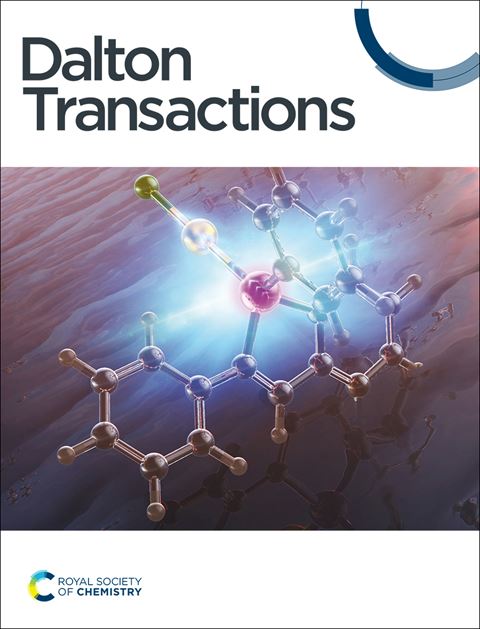Monomeric M(II) (M = Fe, Co, Ni) complexes supported by bulky aryloxide ligands tethered to an arene functionality; synthesis, electrochemistry and study of the M(II)-arene interaction.
IF 3.5
3区 化学
Q2 CHEMISTRY, INORGANIC & NUCLEAR
引用次数: 0
Abstract
The aminolysis reaction between MN’’2 (N’’ = N(SiMe3)2; M = Fe, Co, Ni) and the neutral pro-ligand 6,6'-(1,4-phenylenebis(propane-2,2-diyl))bis(2,4-di-tert-butylphenol) (LH2) affords the low coordinate, isomorphous, monomeric bis-aryloxide complexes (2-M) (M = Fe, Co, Ni). Their molecular structures all feature a basal arene functionality, poised to interact with the metal centre, anchored by two sterically encumbering pendant aryloxide arms. Complexes (2-M) show metal-arene interactions with decreasing strength from (2-Ni), to (2-Co) and finally to (2-Fe). The M-arene interactions were evaluated by a combination of SC-XRD studies, supported by computational investigation and IR spectroscopic characterisation of basal-arene C-C stretches in the absence and the presence of THF in their coordination sphere. The mono-THF adducts (2-Fe.THF) and (2-Co.THF) were also synthesised, isolated and structurally characterised, showing that the M-arene interaction is disrupted upon THF coordination. Cyclic voltammetry (CV) studies of (2-Fe) and (2-Co) show reversible M2+/M+ reduction waves in non-coordinating solvent, and more complex redox chemistry upon THF coordination with (2-Fe.THF) and (2-Co.THF) in THF单体M(II) (M = Fe, Co, Ni)配合物由与芳烃官能团相连的庞大芳酰氧化物配体支撑;M(II)-芳烃相互作用的合成、电化学及研究。
MN“2”(N) = N(SiMe3)2之间的氨解反应;M = Fe, Co, Ni)和中性前配体6,6'-(1,4-苯基双(丙烷-2,2-二基))-(2,4-二叔丁基苯酚)(LH2)提供低配位,同构,单体双芳基氧化物配合物(2-M) (M = Fe, Co, Ni)。它们的分子结构都具有基础芳烃功能,准备与金属中心相互作用,由两个立体阻碍的垂坠芳基氧臂锚定。配合物(2-M)表现出金属-芳烃相互作用,强度从(2-Ni)→(2-Co)→(2-Fe)依次递减。m -芳烃的相互作用通过SC-XRD研究、计算研究和红外光谱表征进行了评估,并在配位球中没有THF和有THF的情况下对基芳烃的C-C拉伸进行了表征。单THF加合物(2-Fe.THF)和(2-Co.THF)也被合成、分离并进行了结构表征,表明间芳烃的相互作用在THF配位后被破坏。(2-Fe)和(2-Co)的循环伏安(CV)研究表明,在非配位溶剂中,(2-Fe.THF)和(2-Co.THF)出现了可逆的M2+/M+还原波,THF与(2-Fe.THF)和(2-Co.THF)配位后,THF中的氧化还原反应更为复杂
本文章由计算机程序翻译,如有差异,请以英文原文为准。
求助全文
约1分钟内获得全文
求助全文
来源期刊

Dalton Transactions
化学-无机化学与核化学
CiteScore
6.60
自引率
7.50%
发文量
1832
审稿时长
1.5 months
期刊介绍:
Dalton Transactions is a journal for all areas of inorganic chemistry, which encompasses the organometallic, bioinorganic and materials chemistry of the elements, with applications including synthesis, catalysis, energy conversion/storage, electrical devices and medicine. Dalton Transactions welcomes high-quality, original submissions in all of these areas and more, where the advancement of knowledge in inorganic chemistry is significant.
 求助内容:
求助内容: 应助结果提醒方式:
应助结果提醒方式:


